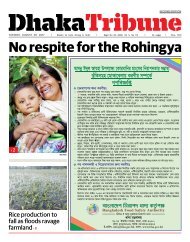e_Paper 1-12-2016
You also want an ePaper? Increase the reach of your titles
YUMPU automatically turns print PDFs into web optimized ePapers that Google loves.
16<br />
THURSDAY, DECEMBER 1, <strong>2016</strong><br />
DT<br />
Feature<br />
Population Growth:<br />
Boon or Bane? A Case in Bangladesh<br />
• Chowdhury Hasanul Panna<br />
The overwhelming<br />
population density of our<br />
country has always been<br />
a matter of great concern<br />
for our economic development.<br />
However, at the same time,<br />
skilled manpower is considered<br />
a resource for a country like<br />
Bangladesh as it plays a key role in<br />
different development sectors and<br />
is critical in boosting a country’s<br />
economy. But what happens if the<br />
population pressure is too high<br />
and exerts excess pressure on<br />
natural resources?<br />
The classical debate whether<br />
population growth is beneficiary<br />
or detrimental to development<br />
has been prevalent through<br />
centuries. In the Eighteenth<br />
century a British reverend and<br />
political economist Thomas<br />
Robert Malthus first proposed<br />
a reverse relationship between<br />
population growth and<br />
development. According to him,<br />
population growth must outstrip<br />
resource base to support that<br />
burgeoning population at some<br />
point, which is popularly known<br />
as Malthusian trap. Therefore,<br />
he suggested population growth<br />
must be checked in order to<br />
prevent poverty, famine or<br />
inequality of wealth distribution<br />
in the society.<br />
Over the course of Nineteenth<br />
and Twentieth century the<br />
Malthusian belief gained ground<br />
around the world, especially<br />
in developing countries like<br />
Bangladesh, India and China.<br />
As they were among the major<br />
food deficit countries and had<br />
been plagued by recurrent<br />
famines and poverty, Malthus<br />
as well as neo-Malthus devotee<br />
like Lester Brown, Paul Ehrlich<br />
argued these countries should<br />
prioritize restricting population<br />
growth rather than expanding<br />
production. They concluded<br />
that development growth will<br />
ultimately fail to catch up to<br />
population growth.<br />
However, there are other<br />
theories from both economic left<br />
and economic right, as well as<br />
empirical evidences that don’t<br />
coincide with this view. The other<br />
school of thought viewed growing<br />
population as an opportunity for<br />
economic development. Ester<br />
Boserup, a Danish economist<br />
presented her argument<br />
regarding population, argued that<br />
population pressure leads to the<br />
invention of modern agricultural<br />
practices and this was also<br />
evident in ancient civilizations.<br />
Women’s role in agriculture and<br />
rural economy brought changes<br />
in the social organization of<br />
the society with more women<br />
directly involved in agricultural<br />
production, which ultimately led<br />
to downward adjustments in their<br />
fertility rate after a period of high<br />
population growth.<br />
Photos: Bigstock<br />
Now the question is whether<br />
Malthusianism really holds water<br />
in Bangladesh or it’s theoretical<br />
mumbo jumbo. No other things<br />
have had such a direct influence<br />
to raising output than population<br />
growth. Interestingly, growing<br />
population act as consumers<br />
too. Farmers reengineered the<br />
production process to sustain<br />
with the population growth and<br />
to raise the level of productivity<br />
or income for ensuring the<br />
household survival. New<br />
technologies are introduced as<br />
well as labour input is raised to<br />
match the productivity.<br />
After independence, the<br />
population of Bangladesh was<br />
around 75 millions, whereas in<br />
<strong>2016</strong> it is about 160 millions.<br />
Though current population is<br />
twice as much as it was in 1971,<br />
Bangladesh has appropriated<br />
food security compared to<br />
1971. Our country has made a<br />
tremendous success over the<br />
past few decades to ensure food<br />
security for its population. High<br />
population density with no new<br />
land for cultivation, our existing<br />
croplands have been used more<br />
efficiently by reducing the fallow<br />
period, introduction of high<br />
yield hybrid crops, crop rotation<br />
system, land management, and<br />
developed irrigation system.<br />
Moreover, Bangladesh is in such a<br />
demographic dividend situation<br />
where almost 11 people are<br />
capable workforce out of every<br />
15. So, there are available inputs<br />
of labour, which can increase the<br />
output as well.<br />
In developing countries like<br />
Bangladesh it has been observed<br />
that Malthusian crisis is waiting,<br />
given extreme pressures on<br />
land and impoverished agrarian<br />
sector. Yet, the diversification<br />
of livelihood created smallscale<br />
income generating source.<br />
Population growth increases<br />
the mouth to feed that directly<br />
creates the demand or market<br />
for the consumption. But if a<br />
society fails to manage it properly,<br />
poverty will increase which will in<br />
turn create a Malthusian trap.<br />
The response of population<br />
growth varies from country to<br />
country and locality to locality<br />
on the basis of their successful<br />
intensification of production.<br />
Considering Bangladesh’s<br />
case, significant increase in<br />
the agricultural production<br />
from 1950 to 1986 through the<br />
intensification process helped<br />
to lower the percentage of the<br />
population below the poverty line<br />
during this period.<br />
Taking all the theories into<br />
account it is quite obvious that<br />
neither model fit exactly in<br />
Bangladesh. Innovations such<br />
as tube well irrigation, high<br />
yielding crop varieties, and<br />
other technologies have meant<br />
that Bangladesh proved selfsufficiency<br />
in food production.<br />
Boserup, however, agree with<br />
Malthus that extreme population<br />
growth may have an adverse<br />
effect on development. Keeping<br />
this in mind, Bangladesh has<br />
succeeded to lower population<br />
growth and still has the<br />
tremendous opportunity<br />
to increase the agricultural<br />
production even further. •<br />
This article was co-authored<br />
by the students of MDS,<br />
Dhaka University.


















